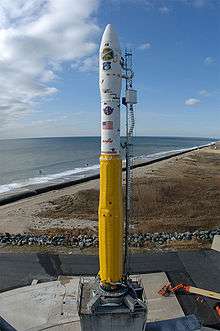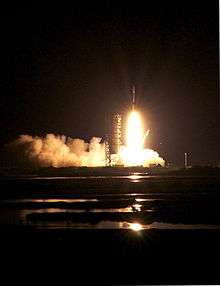Minotaur I
The Minotaur I, or just Minotaur is an American expendable launch system derived from the Minuteman II missile. It is used to launch small satellites for the US Government, and is a member of the Minotaur family of rockets produced by Orbital Sciences Corporation.
 Minotaur I with NFIRE at MARS | |
| Function | Small expendable launch system |
|---|---|
| Manufacturer | Northrop Grumman |
| Country of origin | United States |
| Size | |
| Height | 19.21 metres (63.0 ft) |
| Diameter | 1.67 metres (5 ft 6 in) |
| Mass | 36,200 kilograms (79,800 lb) |
| Stages | 4 or 5 |
| Capacity | |
| Payload to LEO | 580 kilograms (1,280 lb) |
| Payload to SSO | 331 kilograms (730 lb) |
| Launch history | |
| Status | Active |
| Launch sites | Vandenberg SLC-8 MARS LP-0B |
| Total launches | 11 |
| Successes | 11 |
| First flight | 27 January 2000 |
| Last flight | 20 November 2013 |
| First stage – M55A1 | |
| Engines | 1 Solid |
| Thrust | 935 kilonewtons (210,000 lbf) |
| Fuel | Solid |
| Second stage – SR19 | |
| Engines | 1 Solid |
| Thrust | 268 kilonewtons (60,000 lbf) |
| Fuel | Solid |
| Third stage – Orion 50XL | |
| Engines | 1 Solid |
| Thrust | 118.2 kilonewtons (26,600 lbf) |
| Burn time | 74 seconds |
| Fuel | Solid |
| Fourth stage – Orion 38 | |
| Engines | 1 Solid |
| Thrust | 34.8 kilonewtons (7,800 lbf) |
| Burn time | 68 seconds |
| Fuel | Solid |
Vehicle
The Minotaur I was the follow-on to the Orbital Sciences' Taurus (later re-named the "Minotaur-C"[1]) launch vehicle, combining the original Taurus's booster stage with a second stage from a Minuteman missile.
Minotaur I rockets consist of the M55A1 first stage and SR19 second stage of a decommissioned Minuteman missile.[2] The Orion 50XL and Orion 38, from the Pegasus rocket, are used as third and fourth stages. A HAPS (Hydrazine Auxiliary Propulsion System) upper stage can also be flown if greater precision is needed, or the rocket needs to be able to manoeuvre to deploy multiple payloads.[3] It can place up to 580 kilograms (1,280 lb) of payload into a 185-kilometer (115 mi) low Earth orbit at 28.5 degrees of inclination.[2]
Initially Minotaur I launches were conducted from Space Launch Complex 8 at the Vandenberg Air Force Base. Starting with the launch of TacSat-2 in December 2006, launches have also been conducted from Pad 0B at the Mid-Atlantic Regional Spaceport on Wallops Island.[3]
Launch history
There have been eleven launches of the Minotaur I, all successful.
| Flight | Date (UTC) | Rocket | Payload | Launch pad | Trajectory | Result |
|---|---|---|---|---|---|---|
| 1 | January 27, 2000 03:03:06 | Minotaur I | JAWSat (P98-1) (FalconSat1 / ASUSat1 / OCSE / OPAL) | Vandenberg SLC-8 | LEO | Success[4] |
| 2 | July 19, 2000 20:09:00 | Minotaur I | MightySat II.1 (Sindri, P99-1) / MEMS 2A / MEMS 2B | Vandenberg SLC-8 | LEO | Success[5] |
| 3 | April 11, 2005 13:35:00 | Minotaur I | XSS-11 | Vandenberg SLC-8 | LEO | Success[6] |
| 4 | September 23, 2005 02:24:00 | Minotaur I | Streak (STP-R1) | Vandenberg SLC-8 | LEO | Success[7] |
| 5 | April 15, 2006 01:40:00 | Minotaur I | COSMIC (FORMOSAT-3) | Vandenberg SLC-8 | LEO | Success[8] |
| 6 | December 16, 2006 12:00 | Minotaur I | TacSat-2 / GeneSat-1 | MARS LP-0B | LEO | Success[9] |
| 7 | April 24, 2007 06:48 | Minotaur I | NFIRE | MARS LP-0B | LEO | Success[10] |
| 8 | May 19, 2009 23:55 | Minotaur I | TacSat-3 | MARS LP-0B | LEO | Success[11] |
| 9 | February 6, 2011 12:26 | Minotaur I | USA-225 (NROL-66) | Vandenberg SLC-8 | LEO | Success[12] |
| 10 | June 30, 2011 03:09 | Minotaur I | ORS-1 | MARS LP-0B | LEO | Success[13] |
| 11 | November 20, 2013 01:15 | Minotaur I | ORS-3,[14] STPSat-3 and 28 CubeSat satellites[15] | MARS LP-0B | LEO | Success[16] |
| 12 | Q4 2020[17] | Minotaur I | NROL-111[18] | MARS LP-0B | LEO(?) | Planned |
See also
- Comparison of orbital launchers families
- Comparison of orbital launch systems
References
- Clark, Stephen (24 February 2014). "Taurus rocket on the market with new name, upgrades". Spaceflight Now. Retrieved 26 May 2014.
-
"Minotaur I Space Launch Vehicle—Fact Sheet" (PDF). Orbital Sciences Corporation. 2012. Retrieved 2012-02-28.
Spacecraft mass-to-orbit of up to 580 kg to LEO (28.5 deg, 185 km)
- "Minotaur I User's Guide - Release 3.0" (PDF). Orbital Sciences Corporation. Retrieved 1 September 2015.
- Ray, Justin. "Spaceflight Now - Minotaur Mission Report - Mission Status Center - JAWSAT". Retrieved 21 April 2013.
- Ray, Justin. "Spaceflight Now - Minotaur Mission Report - Mission Status Center - Mightysat 2.1". Retrieved 21 April 2013.
- Ray, Justin. "Minotaur rocket launches U.S. military spacecraft". Spaceflight Now. Retrieved 21 April 2013.
- Ray, Justin. "Rocket launch paints sky with breath-taking scene". Spaceflight Now. Retrieved 21 April 2013.
- Ray, Justin. "Spaceflight Now - Minotaur Mission Report - Mission Status Center - COSMIC". Spaceflight Now. Retrieved 21 April 2013.
- Clark, Stephen. "Minotaur rocket makes sunrise ascent from Virginia". Spaceflight Now. Retrieved 21 April 2013.
- Ray, Justin. "Missile research spacecraft soars into orbit from Virginia". Spaceflight Now. Retrieved 21 April 2013.
- Clark, Stephen. "Minotaur lofts experimental satellite for U.S. military". Spaceflight Now. Retrieved 21 April 2013.
- "Orbital Successfully Launches Minotaur I Rocket for U.S. Air Force". Orbital Sciences Corporation. Retrieved 21 April 2013.
- "Orbital Successfully Launches Minotaur I Rocket Carrying ORS-1 Satellite for the U.S. Air Force". Orbital Sciences Corporation. Retrieved 21 April 2013.
- "Media Accreditation Open for ORS-3 Mission from Wallops in November". Retrieved 30 October 2013.
- "Orbital's Minotaur I successfully lofts multitude of payloads". NASASpaceFlight.com. Retrieved 20 November 2013.
- "Orbital Successfully Launches Minotaur I Rocket Supporting ORS-3 Mission for the U.S. Air Force". Wall Street Journal. Retrieved 20 November 2013.
- Clark, Stephen. "AEHF satellite arrives in Florida for first of nearly 20 Space Force launches this year – Spaceflight Now". Spaceflight Now. Retrieved 14 January 2020.
- "Minotaur rocket launch for NRO expected at Wallops by end of 2018". Retrieved 20 September 2018.
- "Fact Sheet" (PDF). Minotaur I. Orbital Sciences Corporation. Retrieved 2009-04-28.
- "Minotaur Mission History". Minotaur I. Orbital Sciences Corporation. Retrieved 2009-04-28.
- "Minotaur I Users Guide" (PDF). Minotaur I. Orbital Sciences Corporation. Retrieved 2015-09-01.
- Wade, Mark. "Minotaur". Encyclopedia Astronautica. Archived from the original on 2009-05-08. Retrieved 2009-04-28.
- Krebs, Gunter. "Minotaur-1 (OSP-SLV)". Gunter's Space Page. Retrieved 2009-04-28.
- Krebs, Gunter. "Minotaur-1 (OSP-SLV)". Gunter's Space Page. Retrieved 2009-04-28.
- Krebs, Gunter. "Minotaur-1 HAPS (OSP-SLV)". Gunter's Space Page. Retrieved 2009-04-28.
